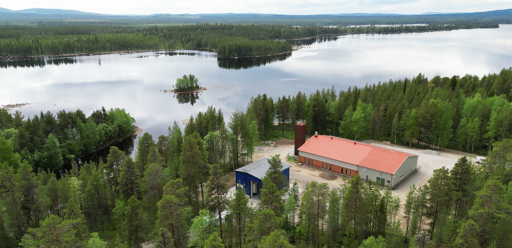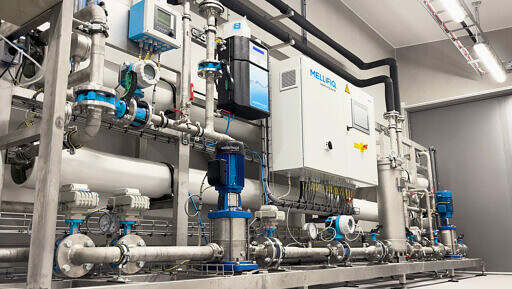
Full Scale API Removal Plant to Comply with EU Active Pharmaceutical Removal Directive
Begär offertUtmaning
Introduktion.
In line with its green strategy, Vilhelmina municipality has recently intensified efforts to protect the environment, with a strong focus on preventing pharmaceutical residues from entering local waterways. The municipality’s largest treatment facility, Vilhelmina Wastewater Treatment Plant, is centrally located near Lake Volgsjön. Although renovated in recent years, the plant lacks a biological treatment stage, resulting in pharmaceutical residues passing through largely untreated and being discharged into the recipient.
Watch the commissioning of Vilhelmina’s pharmaceutical treatment plant.
Problemet.
Traditional wastewater treatment plants are not equipped to handle micropollutants such as active pharmaceutical ingredients (API), as their primary function is to treat organic material. This means pharmaceutical substances often pass through untreated, accumulating in the environment and causing long-term harm. To address this, and also to comply with the pharmaceutical removal standards set by the EU-directive, a full-scale containerized pharmaceutical treatment facility was implemented at the Vilhelmina municipal wastewater treatment plant in northern Sweden.
This plant is the northernmost of its kind to feature advanced pharmaceutical removal and was specifically developed to endure harsh winter conditions and extreme seasonal variations in water flow. The existing facility lacked a biological treatment stage, making the addition of pharmaceutical treatment especially critical. Treated effluent is discharged into Lake Volgsjön, the primary recipient and buffer before the water reaches the Ångerman River — Sweden’s third largest river by volume.
Volgsjön currently has poor chemical and ecological status, with known contaminants such as PFOS from a nearby firefighting training site. The lake is a vital hub for the local community, used for fishing, swimming, and winter activities, and is home to sensitive species like noble crayfish, freshwater pearl mussel, minnow, and trout. By introducing advanced pharmaceutical treatment, the project aims to significantly reduce environmental impact, improve water quality, and ensure the long-term protection of local ecosystems.


Lösningen.
The project began with a thorough preliminary study, including detailed sampling and operational analysis to assess the current state of the facility. These findings formed the basis for the design, dimensioning, and implementation of a robust treatment system, developed in close collaboration with Mellifiq. Drawing on experiencefrom similar installations across Sweden, the system was tailored to Vilhelmina’s specific environmental and operational challenges.
To ensure seamless integration, the new system was installed on adjacent land, as the existing site lacked sufficient space. Special attention was given to the preparation of the terrain — prone to water logging — with excavation work carried out to secure stable conditions for piping and installation. The system is designed to handle a flow capacity of up to 80 m³/h, well above the plant’s average of 69 m³/h, and is capable of maintaining high treatment efficiency even during peak spring flows from snowmelt.
After conventional wastewater treatment, the water enters a fourth and final purification step— known as quaternary treatment — where pharmaceutical residues are removed. This stage is housed in two insulated 40-foot containers, specifically engineered to operate year-round in subzero temperatures and heavy snowfall. The containers are fitted with heating, ventilation, and air conditioning systems, and feature aluminum decking for added protection against moisture and freezing.
Because of the absence of a biological step,the process begins with multimedia filtration to remove suspended solids that remain after conventional treatment. The core of the system is ozonation, where ozone is injected into degassed, pressurized oxidation tanks to oxidize and break down pharmaceutical substances at the molecular level. This step achieves a reduction ofat least 90–95% of pharmaceutical compounds. A final polishing stage ensures any remaining contaminants are removed.
This advanced treatment process not only meets but far exceeds the pharmaceutical removal standards set by the EU Urban Wastewater Treatment Directive. By combining ozonation with granular activated carbon and sand filtration, the system leverages the synergistic effects of oxidation and adsorption for maximum efficiency. The result is a cost-effective, resilient, and future-proof solution — delivering exceptional environmental performance even under the toughest northern conditions.
Utvärdering.
After the installation and commissioning of the pharmaceutical treatment plant at Vilhelmina, an evaluation period of 6–12 months was carried out to ensure that the plant meets the project target of at least 80% reduction of pharmaceutical substances and operates stably under varying flow conditions.
During this period, operating parameters for ozonation and GAC polishing will be optimized through continuous fine-tuning based on analysis results. Monthly sampling of influent and effluent water has been conducted for pharmaceutical residues, transformation products, PFOS, and other water chemistry parameters. The sampling covered various operating conditions, including high-flow periods, to verify the plant’s performance throughout the year.
In parallel, operational stability, energy consumption, and maintenance requirements was documented. The results was compiled in a final report, evaluating the achievement of project objectives and the expected long-term impact on the receiving water body. The report also provided recommendations for the plant’s continued operation and optimization.
By using advanced purification technologies, we have significantly reduced the pollutant load into the local water ways. Our facility in Vilhelmina is not just a solution for local pharmaceutical pollution. It’s a model for how northern communities can effectively address these challenges. Through advanced oxidation, activated carbon filtration and clever process design, we have achieved over 95% reduction.

Relaterade referensprojekt.

Behandling av Förorenat Tvättvatten för att Hålla Sopbilar Rena

Avloppsreningsverk för Borttagning av Läkemedelsrester

Mellifiqs Innovativa Dricksvattenanläggning i Östersund

Mellifiq löser ihärdigt grundvattenproblem med vår AquaFloc

Avancerad vattenrening eliminerar mikroföroreningar och möjliggör för vattenåteranvändning



